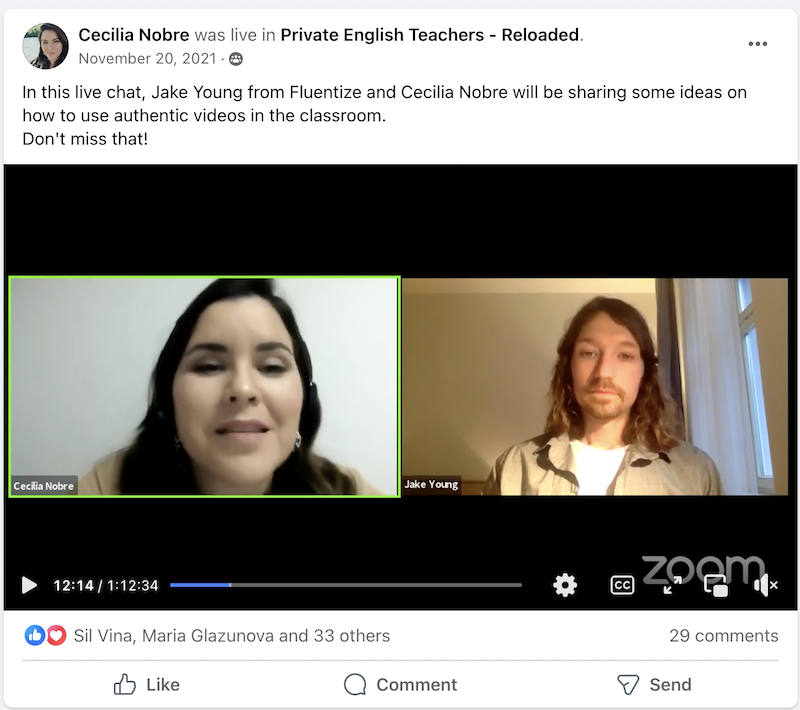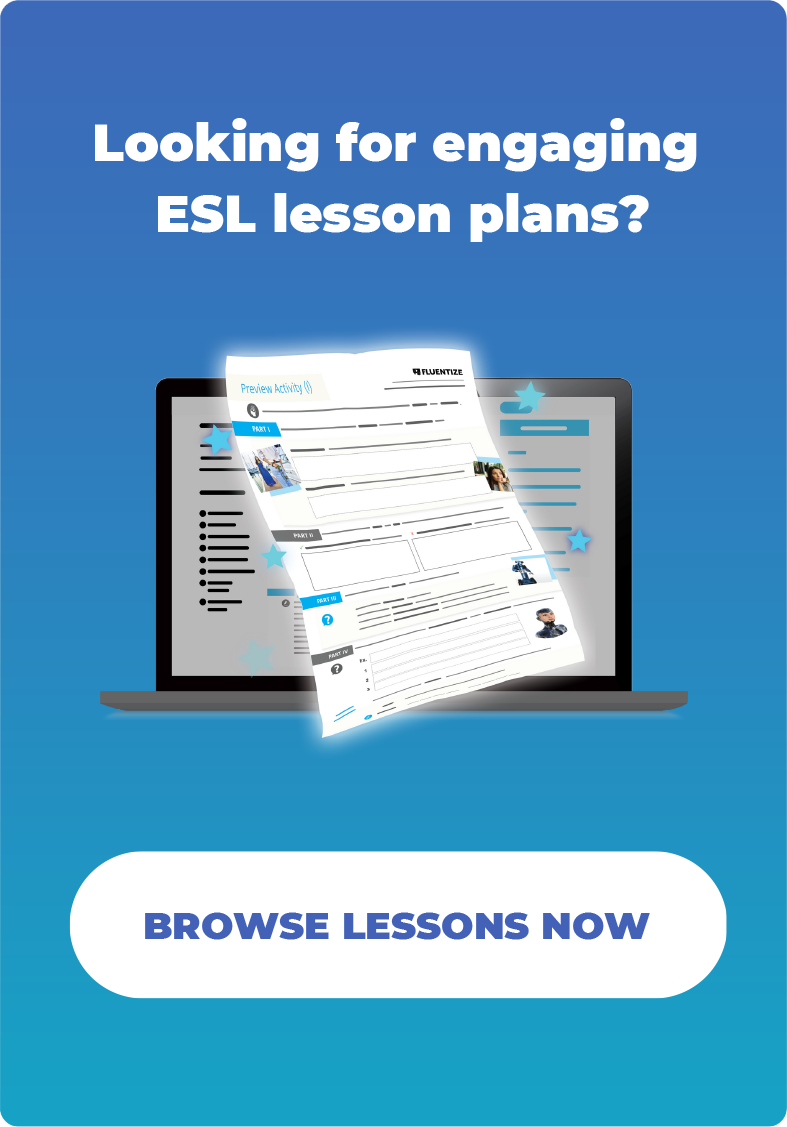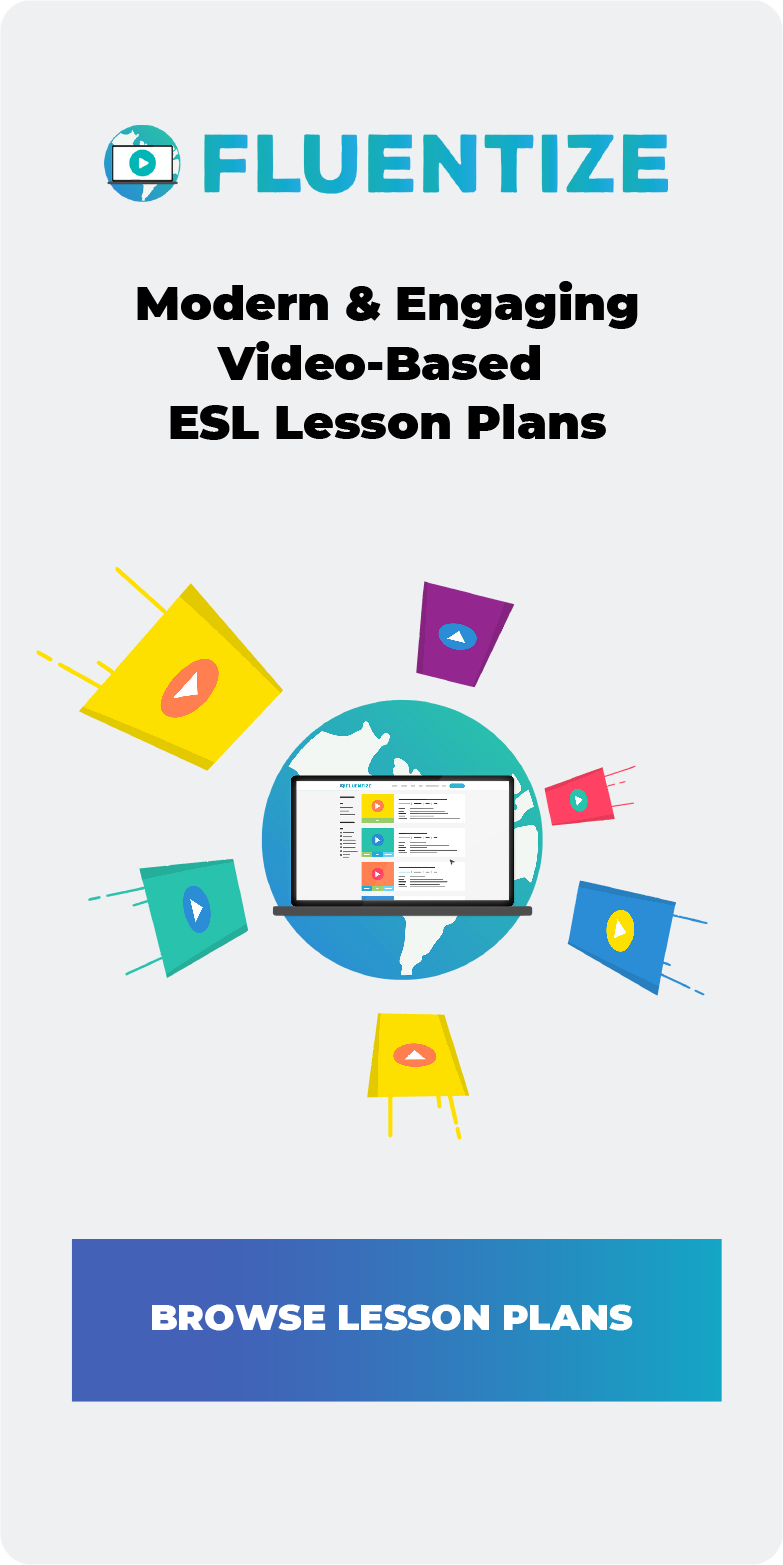Whether you’re a seasoned ESL teacher with years of experience, or a novice teacher just starting out, you’ve probably encountered some kind of obstacles in your role as a teacher.
While it can be very rewarding work, teaching ESL can oftentimes be a rocky road and come with a lot of frustrations.
In my 12+ years teaching English, I’ve experienced it all — low pay, canceled classes, problematic students, tedious admin, lesson planning for hours on end…and the list goes on.
Despite the challenges that come with teaching, I’m grateful to have developed a great passion for the work — a passion that stems from building bonds with my students, helping them reach their personal or professional goals, and having a meaningful impact on their lives.
I’d say there are three main factors that have really helped me develop this passion, grow professionally as a teacher, and pave the path to Fluentize.
Learning a second language
The first has been taking on the great challenge of learning a second language.
When I moved from my hometown in the USA to Prague, Czech Republic to get TEFL certified back in 2011 at The Language House in Prague, I didn’t have any Czech language skills, or really any second language skills at all.
However, as anyone who has lived abroad already knows, daily life can be quite challenging when you don’t speak the local language. Even taking care of basic errands, such as going to the post office, can be very daunting and can lead to a lot of frustration and embarrassment.
I am still currently based in Prague. For anyone who has visited or lived in Prague, you may know how easy it is to fall in love with the city. This is what happened to me in my first few years here. I loved it so much, I began to see a long-term future here. For me, that meant it was time to get serious about learning Czech language.
Czech language is notoriously known for being one of the most difficult languages to learn. Its complex grammar nuances, intimidating pronunciation, and 7 grammatical cases will make your brain want to explode.
From the tiny bit of Czech I did learn during my first few years living in Prague, I knew that if I wanted to get good at it, I would have to take it really seriously and put in the time and effort.
I decided to enroll in intensive Czech language courses for two semesters at the Charles University Institute for Language and Preparatory Studies, and also took private conversation lessons alongside to supplement my studies. I really enjoyed being a language student, and I considered my classes to be a hobby.

Here is a photo of me (on the right) and a Czech čert (devil) coming to visit me in my Czech language course on St. Nicholas Day. This a very fascinating tradition that takes place in the Czech Republic on December 6 every year.
Besides having fun like this in my Czech language courses, I benefited a lot from learning a second language in my personal life.
I liked the feeling of being integrated into a foreign culture and being praised by locals for my language skills. This became a feeling I wanted to pass on and reciprocate to my own students in my teaching practice.
Overall, having spent a lot of time in the classroom as a student of a second language was very valuable in the following ways for my ESL teaching profession:
- Having the ability to translate things for my students when they needed it
- Developing empathy for my students and their learning struggles
- Getting ideas for effective lesson activities for my students (from my Czech language teachers and classes)
- Knowing which cultural topics would benefit and engage students
- Understanding why my Czech students make certain mistakes (for example, Czech language has a very flexible word order, so after learning their language, I also learned why they make mistakes in English like putting the main verb of the sentence before the subject)
Developing my own foreign language skills was like killing two birds with one stone — learning Czech contributed to my own personal growth, which indirectly contributed to my students’ progress.
Writing my own materials
The second factor that really helped me take my teaching abilities to the next level was developing a knack for writing lesson materials for my own students and classes.
In Prague, I spent years building my own teaching practice. With time, I had a full teaching schedule. It mostly consisted of teaching private English conversation lessons to Czech natives around Prague. At the height of my independent freelance teaching practice, I had over 20 of my own private students.
For me, the best part about having my own private teaching practice wasn’t even about the teaching part of it — it was about connecting with my students and building relationships with them.
Ironically, I often felt that I was learning more from my students than they were learning from me, despite the fact that I was their teacher.
Since one of my main goals in each lesson has always been to give students as much speaking time as possible, this gave my students the floor to teach me things about their country’s history and culture, as well as their own areas of expertise, interests, and personal lives.
It’s always amazed me how much you can learn in a 60-minute conversation with someone. For me, one of the best parts about giving English conversation lessons is having the chance to listen and learn about a wide range of topics from students, while also helping them communicate better in English.
As my passion for teaching continued to grow over the years, I also didn’t mind putting in the extra effort to write my own materials for my students.
Even though writing your own materials as a teacher can be really tough and time-consuming (and in most cases, it’s work you don’t get paid for), I actually enjoyed spending my creative energy on it. In addition to learning Czech, materials writing was also something that became a side hobby for me.
While the lesson materials I wrote in the beginning weren’t great at the start, I did strive to get better and better at it.
Naturally, I was writing lesson plans based on topics that fit the needs and interests of my students. Some of those lesson plans I was able to recycle among multiple students to save time.
I tried to incorporate my own materials in some way in each lesson. This was time-consuming, but also worth it, because I’ve always believed that great teachers need great content if they want to help their students succeed.
Here is what a 60-minute lesson typically looked like with one of my students:
- Personal life updates, small talk, & discussion (work, holidays, etc.)
- Discussion about any relevant news topics either locally or globally
- Review of any material we covered in the previous lesson
- Writing down mistakes that students made (and go over them either during or after the lesson)
- Using materials, either my own that I created, or from other resources
When it came to the materials, I often had students read an article or watch a short YouTube video on a certain topic or story, and then we’d use my lesson plans based on them. And 99 times out of 100, videos resonated more strongly with my students.
While news articles can be a really effective resource to use in lessons, in my experience as a teacher, videos tend to create a higher level of student engagement. So videos were undoubtedly one of my go-to lesson resources for almost all of my 20-or-so students that I had.
Since my students appreciated and enjoyed watching videos and learning English through them, many of the lesson materials I was writing had become video-based. This was helping me connect with and have a positive impact on my students.
As I continued creating more and more of my own video-based lesson plans and materials for my students, Fluentize was being conceived without it even being my plan.
Letting my students guide and teach me

Here is an image of two of my students I had in my private teaching practice — Martin (on the left) and Tomas (on the right). Both students are some of the goofiest students I could ever imagine having, but they were such a pleasure to teach. This photo was taken at Office Depot in Prague, where I traveled every Monday and Friday to teach English to a handful of employees at the company.
In the image, Martin and Tomas are holding up some of the first original Fluentize lesson plans. They were the guinea pig students of the lessons.
Martin was actually the first student I ever had, as well as the first student I ever made a video-based lesson for. He is an international business manager at a large office supplies company called Office Depot where the photo above was taken.
Martin preferred a lexical learning approach, and felt that interacting with authentic material really helped him develop his lexical skills. Video-based media sources like movies, TV series, and online videos come filled with all kinds of rich phrasal verbs, colloquial phrases, expressions, and slang that he really benefited from.
It became the norm for me to hunt for interesting video topics and use my creative energy to transform them into English lessons for Martin and my other students. I also felt so grateful to be getting such positive student feedback on the effectiveness of the lessons I was making, and feeling like my lessons were helping my students succeed.
Listening to my students and letting them guide me in regard to what resources, materials, and methods they liked best, I was able to craft something meaningful for them. This ultimately lead me to develop a new skill — ESL lesson and materials writing.
As my writing developed, I became curious to know what kind of feedback I’d get from other ESL teachers on the lesson plans. I started sharing them with other teachers who I knew in Prague. I even met up with a few of the teachers to chat about their experiences using them.
Although I wasn’t necessarily seeking to turn my lesson writing into a business venture, the positive feedback I had gotten from other teachers made me curious to try publishing the lessons onto a website to see how they would perform. I started a website early in 2018, where I published around 30 lessons that I had made for my own students.
With time, Fluentize grew into what it is today. As of October 2023, we have 40,000+ teachers using our lessons, and our lesson plans have racked up hundreds of thousands downloads over the past 5 years.
Fluentize’s Mission
All in all, I’ve found that one of the best ways to connect with your students and take your teaching to the next level is through the right lesson materials — ones that engage them and teach them practical skills effectively.
For me, the formula boils down to this:
Engaging lesson plan → Engaged students → Higher student progress = Meaningful impact
The most challenging part of that formula is the first part — creating engaging lesson plans.
Our main mission with Fluentize has always been to cut that first part of that formula out of the equation for you. My team and I want to help you experience the benefits of using high-quality and engaging video-based lesson materials without having to master the art of lesson planning and writing.
I’ve learned the hard way that creating engaging lesson materials not only consumes a lot of time, but it takes a lot of skill in order to master.
The reality is that most teachers simply don’t have time to spend hours preparing quality materials in the midst of a busy teaching schedule. Especially when it comes to video-based materials, finding the right video and then creating well-structured, comprehensive lesson plans that flow smoothly, engage your students, and help them develop their skills in a methodological way is quite the undertaking.
Moreover, lesson planning is a skill in itself separate from teaching. While TEFL certification programs focus on both the teaching and lesson planning element, teachers still often lack adequate training in the materials writing components after becoming certified to teach. While many teachers can write great materials, this isn’t always the case, and time is also a huge barrier to this.
High-quality lesson plans can really help teachers grow and improve their practice, which is something that I had the privilege of experiencing first hand.
The Fluentize Team
Although it took me many years to develop my lesson writing skills, I also have to attribute a lot of my success as a lesson writer to my colleagues, other collaborators, and users of my lesson plans who have helped guide me and given me valuable feedback. The Fluentize lesson writing and collaborative team is currently made up of a few experienced and creative teachers and materials writers.
I met Cecilia Nobre in the earlier Fluentize years while networking online. She immediately stood out to me with her strong online presence in ELT. Not only does she run Facebook groups such as Private English Teachers – Reloaded, but she’s also co-authored books like Using Video to Support Teacher Reflection and Development in ELT. She has one of the most impressive resumes I’ve ever seen in the field, with experience in ELT that extends far beyond teaching.

As a long-term colleague and collaborator of Fluentize, Cecilia has become an important part of our team’s success. Cecilia’s Fluentize contributions span a wide spectrum of roles, from creating content and managing our social media channels, to offering insightful lesson plan ideas, providing thoughtful feedback and consultation, and actively participating in webinars on various teaching topics.
In the image to the right, Cecilia and I are on a live video chat in the Private Teachers Reloaded group. The topic of our talk was on best practices for implementing authentic videos in your ESL lessons.
Overall, Cecilia’s support has been impactful in Fluentize’s growth, and still continues to collaborate and contribute. She’ll be authoring many of Fluentize’s upcoming blog articles, focusing on educational insights for ESL teachers and professionals.
The next name to mention is Silvina Mascitti. Silvina has a big role in Fluentize’s writing team and authors some of the lessons found in our extensive lesson library. Silvina also provides guidance, support, and feedback on many of the lessons I write, so I must give her credit for my growth as a materials writer. Silvina has a keen eye for crafting effective and engaging lesson activities, building well-structured lessons, and making lessons that both teachers and students love. Silvina also has her own website called EFL Creative Ideas where she creates and shares her own lesson plans.

In the photo to the right, Silvina and I had the opportunity to present on stage together at the Innovate ELT conference in 2022 in Barcelona. In our presentation, titled “Sequence & Flow in ELT Materials Writing,” we shared insights and useful tips for making smooth-flowing materials that keep students actively engaged in class, all based on a lexical and communicative perspective. It was such a great event overall hosted by Oxford TEFL.
All in all, our team at Fluentize strives to empower you in a way that helps lead you to success in your teaching practice. In our own words — we want to help you Fluentize your students!
Lesson plans to help you succeed
Check out some of our free lesson plans to see what a Fluentize lesson looks like — all you have to do is register an account with us for free, and then you can access all of our free lesson plans. We also offer our users some limited time freebies from time to time. Then, we’ve got a library of over 400 more lessons designed to help you take your teaching above and beyond.
Don’t hesitate to reach out at jake@fluentize.com if you have any questions or comments, I’d love to hear from you!
Thanks for listening and hope you enjoy our lessons!

Cheers,










1 thought on “The Journey Of Fluentize: Empowering ESL Teachers With Dynamic Lessons”
Inspiring journey! This beautiful video illustrates how Fluentize’s dedication transforms English learning, giving learners around the world confidence in their fluency.